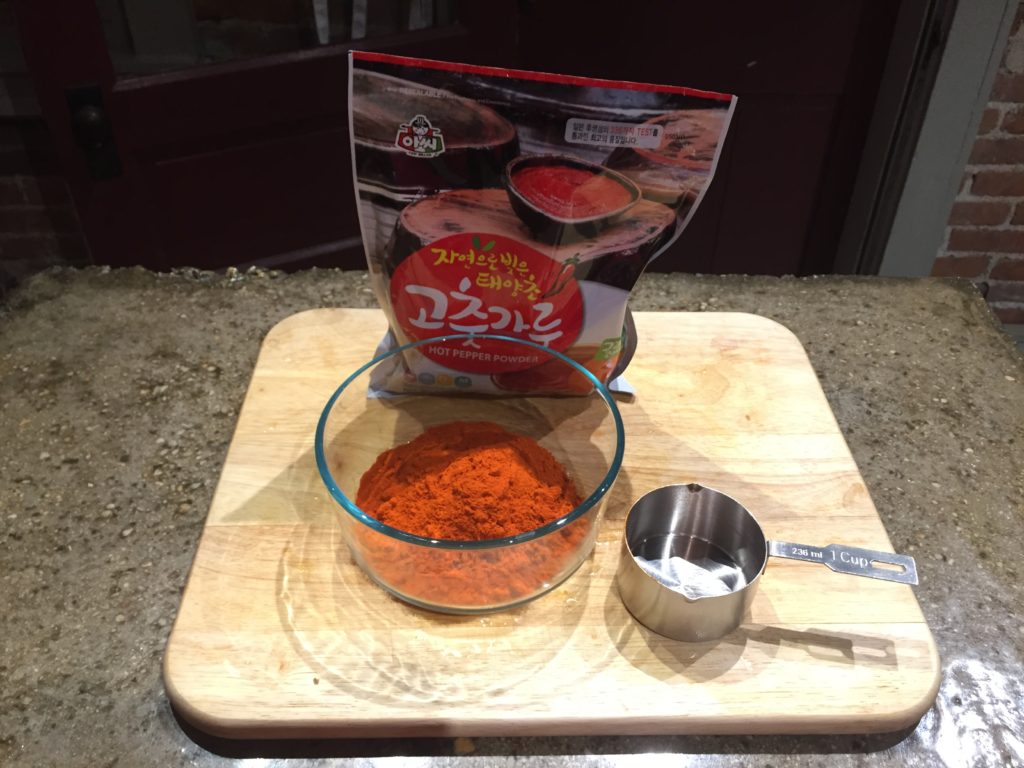If there is one stand out fermented food in my world, it is kimchi. Kimchi is a traditional Korean fermented cabbage. It has the sourness of kraut but the depth of flavors of an amazing pickle. Kimchi also has a mix of flavors that can only be described as having strong Asian roots. Along with the sourness from the fermentation, you get umami from fish sauce and salt brined shrimp. There is sweetness from ginger and a little added sugar. You also get a bitterness and big flavor from red pepper. Together, these layers of flavor make a unique, flavorful, delicious, and healthy ferment. Kimchi is great on it’s own as a snack, I think it pairs well with with beer. It is also great as an addition to soups, rice, stir fry, atop a burger, or as part of many other Asian inspired dishes.

Kimchi Recipe
Ingredients
- 1 Napa cabbage
- Optional handful of carrots (chips or match sticks)
- 1/2 cup kosher salt
- 12 cups cold water (filtered if possible)
- 4 scallions cut into 1-inch pieces (use all but the very end)
- 1/3 cup Korean red pepper powder
- 1/4 cup fish sauce
- 1/4 cup peeled and minced fresh ginger (grate some too for a more pronounced ginger flavor)
- 1 tablespoon minced garlic
- 2 teaspoons Korean salted shrimp, minced
- 1 1/2 teaspoons granulated sugar
- Optional Sriracha sauce (to taste… 1 tablespoon?)
- Optional sesame oil (also to taste… also 1 tablespoon?)
First things first…

Preparing the Napa Cabbage
Preparing the cabbage isn’t hard. You simply want to chop it up. You aren’t making kraut here, so large pieces are good. Your pieces should be about the size of a saltine cracker. Additionally, the fine leaves of the Napa cabbage are something you want to test. If in doubt, include them. However, they will get quite soggy no matter how you prep them. You can leave these pieces in the jar for the starter of the next batch. The fine leaves also make great soup starters and an amazing addition to Ramen! They are super flavorful though, so if you love Kimchi, you may end up eating all of them!
Tip: You can discard the root end. However, you can also finely dice the hardest end pieces (minus the dirty part) and add it to your mix for more flavor.

Put the cabbage, salt, and water in a bowl
After you have chopped the cabbage, add, 1 layer at a time, cabbage, a sprinkling of salt, and some water to a large mixing bowl. You are done when you are out of cabbage, salt, and water. If the layers are off, no sweat, just add everything and mix it all up by hand! The cabbage should rest for at least a couple of hours in the salt water. It can rest as you continue the kimchi recipe. Why are you doing this? This is done to pull some of the moisture out of the cabbage, keeping it somewhat crispy while it ferments. Also, you are making a live probiotic fermented food! Iodine and Chlorine are not your friends! Those two things kill bacteria. So, use non-iodized salt and filtered water.
Tip: Some folks soak their cabbage overnight. Please experiment and look for any differences in the taste or texture when performing vs. omitting this step. You could leave all the prep work for the other ingredients until after the cabbage is on salt water. The cabbage would rest for about 2 hours in this case. It is also possible to get started in the morning and finish up later in the day, producing the same results.

Making the red pepper paste
As the cabbage rests, you can start on the red pepper paste. Add the red pepper, scallions, fish sauce, fresh ginger, minced garlic, salted shrimp, sugar, and optional ingredients to a medium sized mixing bowl.
Tip: Fish sauce is an interesting ingredient. Be warned, it is a bit pungent! It can smell quite strong and even “rotten” to some folks. Trust me though, it tastes a lot better than it smells! Open a window if you can’t handle the smell and are in tight quarters!

Salt brined shrimp from the Asian market
What are salt brined shrimp? Well, they can be found at an Asian or specialty market. You can make kimchi without them if you can’t get any. I would add a bit more fish sauce in that case.

Mix the ingredients well
Mix all the ingredients together. You should get a paste. If the consistency is too hard, like play dough, a splash of filtered water or more fish sauce will soften it. If it is too runny, like a thick soup, a bit more pepper powder will help. This isn’t baking, the measurements are just a guide!

Rinse and drain the cabbage
Prepping the ingredients and making the paste probably didn’t take 2 hours. You can leave everything sit for a bit. Also, it isn’t the end of the world to just get started.
You want to thoroughly rinse and drain the cabbage. I use tap water to rinse thoroughly, and then filtered water for one final rinse. You don’t need to pat it dry or use a colander, but you don’t want any noticeable water left in the bowl.
Salt or no salt for Kimchi
So here is an interesting question for many fermenters. How much salt needs to be added? After all, most fermenting recipes call for a salt brine. Notice, the recipe hasn’t called for any salt beyond what was used to soak the cabbage and you rinsed all of that away! If you have read the past post: Pickles and Probiotic Fermentation you will know that the recommendation at JerkyPicklesandBeer.com is to use a starter culture or a live starter from a previous batch. Avoiding salt is healthier and our opinion is that it tastes better. However, there are benefits for maintaining about a 2%-3% salinity in your mix.
The correct salinity is absolutely necessary if you don’t have a starter culture. If you are salt brining, you should have some guidelines. Some folks really get into their brine, weighing the salt, and keeping strict salt percentages. This is surely important as your batch sizes increase and certainly if you aren’t using airlocks or live starter cultures. Per the past pickling article, the salt creates an environment for the good bacteria to thrive and the bad bacteria to be crowded out. It also prevents spoilage from various yeasts and molds. If you aren’t protecting your ferment with time, temperature, and salinity, you can create some gross ferments, and at worst, poison your friends and family!
- Time – Live starter cultures speed up the time it takes for good bacteria to be dominant.
- Temperature – There are specific temperatures where good and bad bacteria thrive. Below 64 degrees is the safest, but slow. Below 72 degrees is mostly safe and a bit faster.
- Salinity – 2% for most vegetables, 2.5% up to 3.5% for various types of pickles, sourness, and flavors.
In each of these cases, experimenting can create different flavor profiles.
Brine Percentages
2% brine – For most vegetables – Using small granulated sea salt.
Just under 1 teaspoon salt per cup of water, 3.5 teaspoons of salt per Quart (4 cups).
For various pickled vegetables, especially cabbage (kraut and kimchi), you can also measure by weight of the cabbage used.
This would measure out at just under 4 teaspoons (3.87 teaspoons) per 5 pounds of cabbage.
Larger grains of salt actually weigh out and convert to just a bit less volume of salt required. I am not a microbiologist, and I have never found that these minute differences have ever impacted my end results.
Ok, enough about salt. If you want to get a lot of detail about brine, I will point you to one of many resources available: Brine Recommendations
Mixing the cabbage and the red pepper paste
This is messy! It’s quite fun though! You want to grab some paste and some cabbage, knead it together in your hands. I believe thoroughly kneading the cabbage improves the final results. Continue this process until the cabbage and paste are all combined into a large mixing bowl. If you don’t have red pepper paste all over your hands, you are doing it wrong! Once all the cabbage and paste is combined, continue kneading the cabbage in the bowl. You want to have a good amount of natural liquid created. It should start to get soupy. This is when you will add the carrots if you choose.

The Fermenter
With all the ingredients finally combined and appropriately massaged and mashed, it is time to add it to the fermenter. I use half gallon ball jars with fermenting air locks. There are a ton of options on the market. The trick here is to get all the air out. Place a handful of mix into the fermenter and mash it down with some sort of tool. I have a specialized wooden masher. A spatula should work. Don’t mash too hard that you break apart the cabbage or break the jar! As the next few handfuls are added, the mashing works a bit better. Again, you want the kimchi packed tight in order to displace air bubbles. Continue adding the kimchi mix and mashing until you have about 3 inches of space remaining. This batch should be the perfect amount. Pour the remaining liquid into the fermenter until there is about 2 inches of space at the top.
Tip: To reduce the mess, I recommend getting a large mouth canning funnel.
Tip: If you bought a very large head of Napa cabbage, you may need to mash a bit more or use two jars.
Tip: If you don’t get enough liquid from your massaging, kneading, and mashing, you can use the above mentioned 2% brine to top off the jar, leaving about 2 inches of space.

Tip: Don’t fill it too high! Use a fermentation weight or a specially designed spacer. Most fermenting kits come with one or the other. Do you want kimchi juice all over the place? That’s what will happen if you fill it too full.

Fermenting
In the summer, I move my jars to the basement to ferment. It is about 60-68 degrees there in the summer. I have a shelf in the basement stairway that stays right about 70 degrees during the summer. The fermenter will live there for a few days. Those are pretty optimal conditions. I do prefer to get my batches up to a sustained 70 degrees for at least a day or two. Don’t let it go over 72 degrees for very long, if ever. In the winter, it’s a bit harder to find the optimal conditions. The jars live on the kitchen counter. The kitchen in the winter ranges from 58 degrees overnight to about 68 with the heat running. This probably isn’t the best conditions to start a batch. You can certainly start a batch at lower temperatures, but the fermenting will take quite a bit longer.
Tip: Get your fermenting done before the dead of winter! If you live in a warmer climate or have access to environmentally friendly optimal conditions, have at it all year long!
Fermenting is both art and science. You can have a batch of kimchi fermented in only a few days under optimal temperatures.
I never ferment for this short amount of time. The longer you ferment, typically, the more flavorful and complex the results. After an initial few days of 70 degrees, I go to a colder location for weeks, even months of additional fermenting. Some kimchi can be fermented for years! Tobasco, the hot sauce, lives in salt sealed barrels for multiple years before it’s bottled and sold!
Fermenting is amazing!



